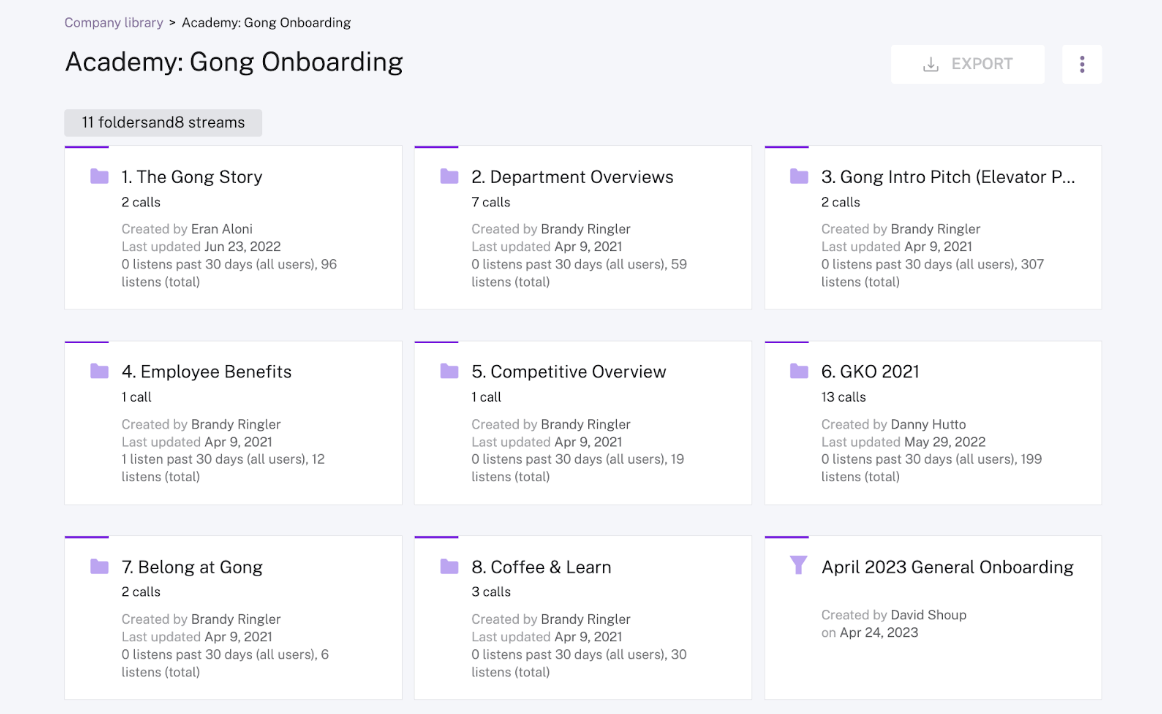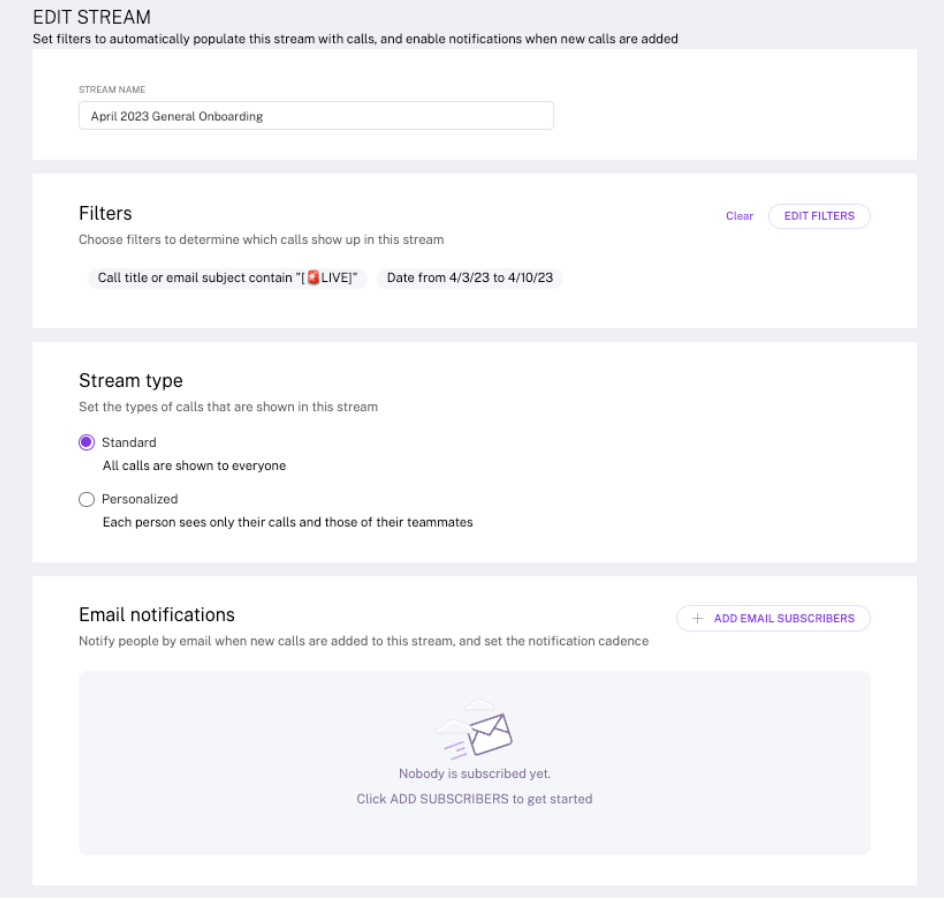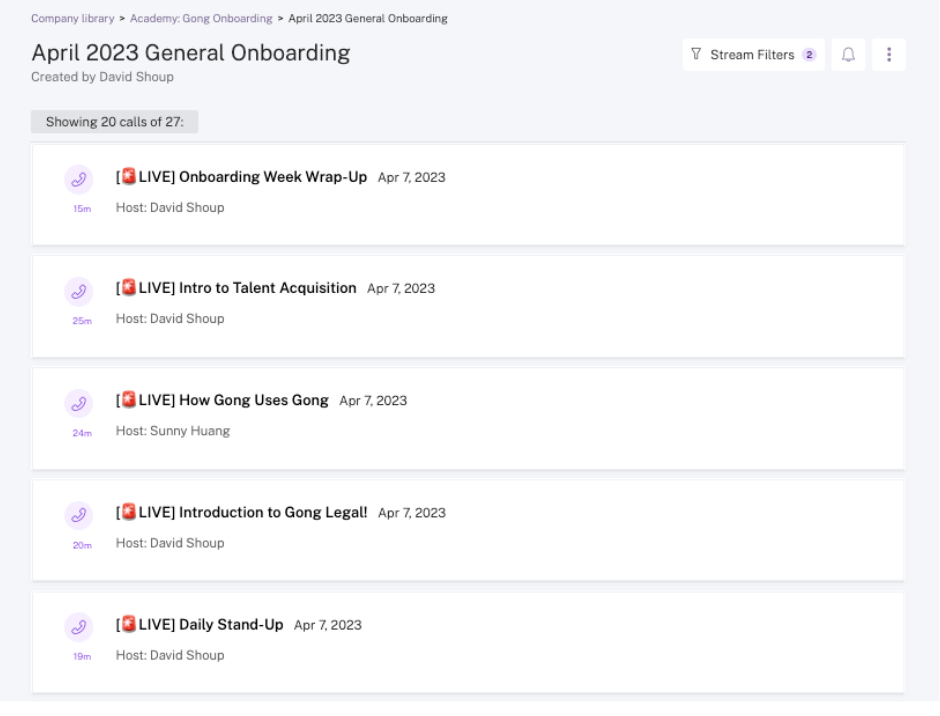GONG RECIPE BOOK
Onboarding New Team Members Faster with Gong
Ingredients: Library folders, Streams, Collaboration
What is it?
Hiring exceptional individuals, particularly sales representatives, is crucial to the success of your team. But what happens after the hiring process? How can you help new hires reach their full potential quickly? With Gong, it’s easy to create a predefined onboarding program that efficiently guides new hires to meet their sales targets as quickly as possible.
Who is it for?
It’s in every organization’s interest to have a streamlined onboarding process. When onboarding is smooth, new team members are integrated into the team and can understand their role and find their footing more quickly and easily. Instead of having to feel their way around in the dark, new team members have a very clear playbook they can follow, which means they’ll get to know the organization and be able to start working very shortly after joining.
JUMP TO SECTION TO LEARN MORE
How does Gong help out?
Gong provides ready-to-use functionality that facilitates an efficient onboarding process. Some of its features include:
- One-time investment for the onboarding program: Gong allows you to record onboarding sessions and demonstrations, which can then be shared and reused easily. This ensures that the onboarding program remains up to date and continues to serve newcomers effectively.
- A centralized location: Gong provides a library folder that can include subfolders aligned with the company’s sales process. These subfolders can be categorized based on sales stages, topics, skills, and more.
- Onboarding folder options: You can choose between public and private folders. Public folders are available within the company and mainly used for training and onboarding at a company level (by sales enablement. They grant access to all calls in the shared folder (excluding private calls and streams) to anyone with folder access, regardless of their own permission profile. Private folders are used for exclusive content and unique onboarding related to a specific team and are mainly used by frontline managers.
- Up-to-date learning content shared at once: Gong automates the curation of onboarding-folder content with Streams, “smart folders” that automatically gather calls based on certain filtering criteria, rather than manual management. Teams can set up email and Slack notifications for streams, so they get notified (immediately or on a daily or weekly basis) when new relevant calls are added. Additionally, sales enablement can personalize streams so viewers only see calls related to their teams. This makes it possible to set up just one stream, which automatically adjusts its content based on the viewer, reducing the enablement work and maintenance.
- Ongoing collaboration with the team/mentor/manager: Gong users can tag individuals or mention them in the comments of a call, so they can ask questions in context.
- An app for listening on the go: With the Gong app, team members can access their library and listen no matter where they are.
How does it work?
1. Create a master Onboarding program library
Involve others from your organization in the onboarding program so they’re invested in its success. Ask reps, managers, and executives to run onboarding sessions. This keeps the sessions fresh and interesting and connects new hires with the organization’s leaders.

2. Define your listeners and set up a stream (10 minutes):
Within the library, you can create either a static folder (similar to the previous step) or a personalized stream. When creating a stream, you’ll be asked to set specific content filters.
You can also personalize the stream to only display the calls that apply to specific teams or team members. New team members can then subscribe to a stream and automatically receive curated content that matches the criteria and their role.


3. Encourage team members to collaborate in context:
As a recruiting manager, you can foster a collaborative environment by encouraging team members to engage in dialogue, ask questions, and provide answers within the context of the calls. This can be done by pointing to selected snippets of the call, commenting on them, and specifically tagging individuals or teams. This type of interaction promotes healthy and accurate discussions as an integral part of the onboarding process.
4. Stay on top of coaching efforts
Part of creating a standardized, structured coaching program involves ensuring that managers stay on top of their coaching to-do’s. Managers can use the Coaching Inbox, streams, and subscriptions to keep up with their coaching efforts. They can also use the Coaching Metrics tab to compare their own coaching efforts with those of their peers.
Pro tips
Involve others from your organization in the onboarding program so they’re invested in its success. Ask reps, managers, and executives to run onboarding sessions. This keeps the sessions fresh and interesting and connects new hires with the organization’s leaders.
Identify coaching moments and create hashtags for them. This lets sales enablement collect these moments automatically using streams and be notified whenever new calls are tagged with them.